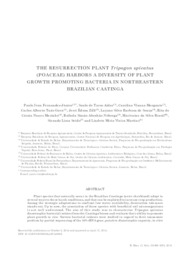The resurrection plant tripogon spicatus (Poaceae) harbors a diversity of plant growth promoting bacteria in Northeastern Brazilian Caatinga.
The resurrection plant tripogon spicatus (Poaceae) harbors a diversity of plant growth promoting bacteria in Northeastern Brazilian Caatinga.
Author(s): FERNANDES JUNIOR, P. I.; AIDAR, S. de T.; MORGANTE, C. V.; GAVA, C. A. T.; ZILLI, J. E.; SOUZA, L. S. B. de; MARINHO, R. de C. N.; NÓBREGA, R. S. A.; BRASIL, M. da S.; SEIDO, S. L.; MARTINS, L. M. V.
Summary: Plant species that naturally occur in the brazilian Caatinga (xeric shrubland) adapt in several ways to these harsh conditions, and that can be exploited to increase crop production. among the strategic adaptations to confront low water availability, desiccation tolerance stands out. Up to now, the association of those species with beneficial soil microorganisms is not well understood. The aim of this study was to characterize Tripogon spicatus diazotrophic bacterial isolates from the Caatinga biome and evaluate their ability to promote plant growth in rice. Sixteen bacterial isolates were studied in regard to their taxonomic position by partial sequencing of the 16S rRna gene, putative diazotrophic capacity, in vitro indole-acetic acid (IAA) production and calcium phosphate solubilization, metabolism of nine different C sources in semi-solid media, tolerance to different concentrations of NaCl to pHs and intrinsic resistance to nine antibiotics. Finally, the ability of the bacterial isolates to promote plant growth was evaluated using rice (Oryza sativa) as a model plant. Among the 16 isolates evaluated, eight of them were classified as Enterobacteriaceae members, related to Enterobacter and Pantoea genera. Six other bacteria were related to Bacillus, and the remaining two were related to Rhizobium and Stenotrophomonas. The evaluation of total nincorporation into the semi-solid medium indicated that all the bacteria studied have putative diazotrophic capacity. Two bacteria were able to produce more IAA than that observed for the strain BR 11175 of Herbaspirillum seropedicae. Bacterial isolates were also able to form a microaerophilic pellicle in a semi-solid medium supplemented with different NaCl concentrations up to 1.27 mol l-1. intrinsic resistance to antibiotics and the metabolism of different C sources indicated a great variation in physiological profile. Seven isolates were able to promote rice growth, and two bacteria were more efficient than the reference strain Azospirillum brasilense, ab-v5. The results indicate the potential of T. spicatus as native plant source of plant growth promoting bacteria.
Publication year: 2015
Types of publication: Journal article
Unit: Embrapa Semi-arid Region
Keywords: Bactéria, Bactérias diazotróficas, Biological nitrogen fixation, Bioma Caatinga, Caatinga, Diazotrophic bacteria, Fixação biológica de nitrogênio, Fixação biológica do nitrogênio, Fixação de nitrogênio, Inoculant, Inoculante, Plantas tolerantes à dessecação, Semiárido, Soil, Solo, Tolerant plants
Observation
Some of Embrapa's publications are published as ePub files. To read them, use or download one of the following free software options to your computer or mobile device. Android: Google Play Books; IOS: iBooks; Windows and Linux: Calibre.
Access other publications
Access the Agricultural Research Database (BDPA) to consult Embrapa's full library collection and records.
Visit Embrapa Bookstore to purchase books and other publications sold by Embrapa.

